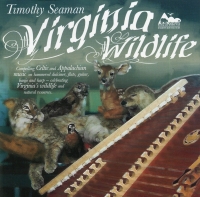|
Album Liner Notes 1. Bobcat in the Mountain Laurel (trad. Scot.) At Clinch Mountain Wildlife Management Area (WMA) are deep forests full of intriguing wildlife: you’ll see much Mountain Laurel, but probably never the reclusive Bobcat (Lynx rufus) --- yet he’ll see you! Guest artist: the Wood Thrush (Hylocichla mustelina) who owns the tree outside our living room. Thanks to Alisdair Fraser for the tune in The Road North. Star of the County Down (trad. Scots-Irish) Several branches of my family came over from County Down,Northern Ireland; much of the Virginias was settled by such hardy Scots. The Osprey Returns (flute improvisation --- © T. Seaman) York River State Park and Hog Island WMA are home to many Ospreys (Pandion haliaetus) who nest along the shore and migrate each year to South America. These noble fish eagles have come back marvelously during my lifetime --- as have the Whitetail Deer, Bald Eagle, Pileated Woodpecker, and Beaver. 2. Cumberland Gap (trad. Am.) Daniel Boone’s gap at the junction of Virginia, Kentucky and Tennessee is home to the drumming logs of many Ruffed Grouse (Bonasa umbellus); Red-Tailed Hawks (Buteo jamaicensis) swoop through on their yearly pilgrimages. For Cumberland Gap National Historical Park and Wilderness Road State Park, as well as the Smooth Earth Snake (Virginia valeriae). 3. Who’s Awake? Me Too! (© T. Seaman) For Dick Cross WMA. Among the many animals bearing Virginia’s name are the Great Horned Owl (Bubo virginianus) and the Northern Bobwhite (Colinus virginianus). The nocturnal owl here greets the morning, as does the diurnal quail. The tune is based on the two birds’ calls, in Joe Weed’s manner in Waltz of the Whippoorwill. 4. Virginia Rail Reel (© T. Seaman) In swamps along the Virginia Birding and Wildlife Trail dwell perky walking birds (Rallus limicola) with our state’s name. Ducks on the Pond (trad. Am.) Thanks to Dwight Diller for the tune. Iridescent-headed Mallards (Anas platyrhynchos) keep things active at our nearby beaver pond. Old Blue (trad. Am.) In honor of the many faithful hunting dogs throughout Virginia --- among the truest of friends! 5. Great Blue Heron (Jesus Calms the Sea --- © P. Skeens) For Princess Anne WMA. Ardea herodias presides over salt water and fresh throughout the state; once I saw one glutting himself on fish in a draining beaver pond. Here he encounters a brief thunderstorm. 6. Little Brown Bats Eating Mosquitos (© T. Seaman) If you come across a sleeping bat (Myotis lucifugus) during the day and look into his snarling, blinking face, he may not appear as true a friend as he is, eating thousands of insects a night! In honor of Virginia’s Non-Game Wildlife Tax Checkoff. 7. Mairie’s Wedding (trad. Scot.) For the colorful scorpion-like spider in Short Pump,VA, who perched on the microphone while I played flute for the bride’s processional at an outdoor wedding --- then he hopped onto my cheek for the final part, somehow knowing I was helpless to brush him away! 8. The Butterfly (trad. Ir.), Swallowtail Jig (trad. Ir.) In honor of Virginia Habitat Partners. The Virginia State Insect is the Eastern Tiger Swallowtail (Papilio glaucus). Virginia Ctenucha Moth (© T. Seaman) This creature (Ctenucha virginica) resembles a wasp as it visits our flowers. 9. Bass Fisherman’s Reel (trad. Eng.) For Briery Creek WMA. My dad, Woody Seaman, was president of the American Fisheries Society and angled often for Largemouth Bass (Micropterus salmoides). After he had to become a bureaucrat, he talked often of his longing to return to fieldwork. Falls of Richmond (trad. Am.) Thanks to Dwight for the tune. Richmond, on the James River fall line, has an urban wilderness of rushing water, rocks and islands. Crawdad (trad. Am.) “You get a line and I’ll get a pole, honey --- we’ll go down to the crawdad hole!” As a child, I loved these crustaceans (Cambarus bartoni), and studied them for a teen science project. 10. Cockles and Mussels (J.Yorkston, 1884) Our neighborly thrush brings an encore. Mussels gather in great masses in York River State Park, filtering brackish water for food. Thanks to John Gary for his moving version of this piece in the 1960’s. 11. Baldcypress Swamp (© T. Seaman) First Landing State Park in Virginia Beach astonishes the visitor with its rich blackwater swamp beneath great Baldcypresses slung with Spanish Moss, at the very spot the Jamestown settlers first set foot in the Virginia Colony in 1607. To the west, Chickahominy WMA exhibits similar diversity of wildlife. 12. Turkey in the Straw (trad. Am.) Just before dawn at Turkeycock WMA, two Wild Turkey (Meleagris gallopavo) hens cluck, cackle, yelp and purr as they scratch the earth; later a Barred Owl (Strix varia) calls too close to a tom, who gobbles in disgruntled response. 13. The Bear (trad. Flemish) Have you met a Black Bear (Ursus americanus) on the prowl in Shenandoah National Park as he searches for grubs and berries? The Raccoon (drum circle improvisation --- © T. Seaman) Another prowler (Procyon lotor) can be a rascally “camp robber,” yet is a meticulous stream forager. The Fox (trad. Eng.) This old folk song celebrates a Red Fox (Vulpes vulpes) family’s joy at a dinner of farmers’ animals! Spring in the Gap (© T. Seaman 1997) For the Shenandoah Salamander (Plethodon shenandoah), which lives only on Pinnacles, Hawksbill and Stony Man Mountains in the Park. 14. Deer of the Dawn (© T. Seaman) An improvisation depicting the moments before daybreak at Highland WMA as a group of Whitetail Deer (Odocoileus virginianus) browse in the dew. The title is taken from the heading of Psalm 22. 15. Heavenly Dove (trad. Am.)/Feathered Dove (Solitude in the Grove — trad. Am.) For Amelia WMA. Both of these old folk hymns have words referring to the Mourning Dove (Zenaida macroura): Isaac Watts’ “Come, Holy Spirit, heavenly dove” and “O were I like the feathered dove and innocent had wings,” the latter taken from Psalm 55:6. 16. Eagles’ Wings (Lancaster — trad. Am.) This folk hymn bears words by Wesley about the wonder of Heaven: “O glorious hope of perfect love!… It bears on eagles’ wings.” We also rejoice in the recent surge of Bald Eagle (Haliaeetus leucocephalus) nestings throughout Virginia. Jamestown Island, Colonial National Historical Park, is home to several pairs of the noble American raptor. One great bird hovered over the York River bluff next to my window as I recorded. To the memory of pianists Arthur Rubinstein and Glenn Gould. 17. Largo from Symphony 9 “From the New World” (A. Dvorak, 1893) The Czech master lived in America in the 1890’s; he loved our land but wrote music here that was homesick for Bohemia --- still, the melodies echoed those of African Americans he knew and Longfellow’s story Hiawatha. For G. Richard Thompson WMA, and my mother, Dorothy Seaman. 18. The Cuckoo’s Nest (trad.Am.) At Land’s End WMA,Yellow-billed Cuckoos (Coccyzus americanus) hang out in thickets and make their raucous calls. Redwing (K. Mills, 1907) Red-winged Blackbirds (Agelaius phoeniceus) dangle on dry reeds in Tidewater estuaries. Listen to the Mockingbird (R.Milburn, 1855) The first time I performed this, at the Virginia Living Museum, a Northern Mockingbird (Mimus polyglottos) went nuts overhead with his good-natured string of songs. In the version here, note the whistle’s similar spirit! |
| MAIN | SONG LIST | LINER NOTES | BUY MUSIC |




 Virginia Wildlife (2004)
Virginia Wildlife (2004)